
Psidium is a genus of trees and shrubs in the family Myrtaceae. It is native to warmer parts of the Western Hemisphere.
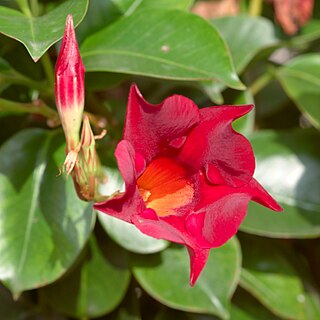
Mandevilla is a genus of tropical and subtropical flowering vines belonging to the family Apocynaceae. It was first described as a genus in 1840. A common name is rocktrumpet.

Manihot is a genus in the diverse milkspurge family, Euphorbiaceae. It was described as a genus in 1754.

Microstachys is a genus of plants in the Euphorbiaceae first described as a genus in 1824. It is native to tropical Africa, southern Asia, Australia, Papuasia, Mesoamerica, the West Indies, and South America.

Myrciaria is a genus of large shrubs and small trees described as a genus in 1856. It is native to Central and South America, Mexico, and the West Indies, with many of the species endemic to Brazil. Common names include hivapuru, sabará, and ybapuru.
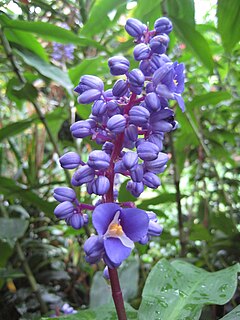
Dichorisandra is a genus of perennial monocotyledonous flowering plants in the dayflower family (Commelinaceae). It is found in the neotropics. The genus is characterised by its slightly zygomorphic flowers with large anthers usually releasing pollen by means of pores at the apex, as well as by its seeds that are embedded in a red or sometimes white aril, and tubers that often form at the tips of the roots. Both morphology and an analysis of DNA sequences indicate it is very closely related to the genus Siderasis.

Vriesea is a genus of flowering plants in the botanical family Bromeliaceae, subfamily Tillandsioideae. The genus name is for Willem Hendrik de Vriese, Dutch botanist, physician (1806–1862). Its species are widespread over Mexico, Central America, South America and the West Indies.

Billbergia is a genus of flowering plants in the family Bromeliaceae, subfamily Bromelioideae. The genus, named for the Swedish botanist, zoologist, and anatomist Gustaf Johan Billberg, is divided into two subgenera: Billbergia and Helicodea. They are native to forest and scrub, up to an altitude of 1,700 m (5,577 ft), in southern Mexico, the West Indies, Central America and South America, with many species endemic to Brazil.
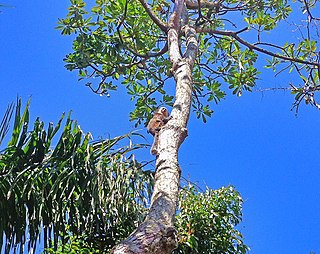
Himatanthus is a genus of flowering plant in the family Apocynaceae, first described as a genus in 1819. It is native to Panama and South America.
- Himatanthus articulatus(Vahl) Woodson - widespread from Panama east to French Guiana and south to Bolivia
- Himatanthus attenuatus(Benth.) Woodson - Venezuela, Colombia, N Brazil
- Himatanthus bracteatus(A.DC.) Woodson - Venezuela, Colombia, Guianas, Brazil, Peru, Ecuador
- Himatanthus drasticus(Mart.) Plumel - Guianas, Brazil
- Himatanthus lancifolius(Müll.Arg.) Woodson
- Himatanthus obovatus(Müll.Arg.) Woodson - Brazil, Bolivia, Guyana
- Himatanthus phagedaenicus(Mart.) Woodson - S Venezuela, NW Brazil
- Himatanthus semilunatusMarkgr. - Amazon Basin
- Himatanthus stenophyllusPlumel - Colombia, NW Brazil, Guyana, Suriname
- Himatanthus tarapotensis(K.Schum. ex Markgr.) Plumel - Colombia, Bolivia, Brazil, Peru, Ecuador

Lepechinia is a genus of plants in the mint family, Lamiaceae. It includes several species of plants known commonly as pitchersages. Plants of this genus can be found in Central and South America, Mexico, California, Hispaniola, and Hawaii, although the species in Hawaii is probably a human introduction. Many of them bear attractive pitcher-shaped flowers, often in shades of purple. The genus was named for the Russian botanist Ivan Ivanovich Lepechin. Recently, the two monotypic genera Chaunostoma and Neoeplingia were shown to be part of Lepechinia.
- Lepechinia anomalaEpling - southern Brazil
- Lepechinia bellaEpling - Bolivia
- Lepechinia betonicaefolia(Lam.) Epling - Colombia, Ecuador
- Lepechinia bullata (Kunth) Epling - Colombia, Ecuador, Venezuela
- Lepechinia calycina(Benth.) Epling ex Munz – pitcher sage, woodbalm - California
- Lepechinia cardiophyllaEpling – Santa Ana pitcher sage - southern California, Baja California
- Lepechinia caulescens(Ortega) Epling - Mexico, Guatemala
- Lepechinia chamaedryoides(Balb.) Epling - Chile
- Lepechinia cocuyensisJ.R.I.Wood - Colombia
- Lepechinia codonEpling - Peru
- Lepechinia conferta(Benth.) Epling - Colombia, Venezuela
- Lepechinia dioicaJ.A.Hart - Ecuador
- Lepechinia flammeaMart.Gord. & Lozada-Pérez - Guerrero
- Lepechinia floribunda(Benth.) Epling - Peru, Bolivia, Argentina
- Lepechinia fragrans(Greene) Epling – island pitcher sage, fragrant pitcher sage - southern California including offshore Channel Islands
- Lepechinia ganderiEpling – San Diego pitcher sage - southern California, Baja California
- Lepechinia glomerataEpling - Jalisco
- Lepechinia hastata(A.Gray) Epling – pakata - Baja California and Baja California Sur, including Revillagigedo Islands; naturalized in Hawaii
- Lepechinia heteromorpha (Briq.) Epling - Ecuador, Peru, Bolivia
- Lepechinia lamiifolia(Benth.) Epling - Ecuador, Peru
- Lepechinia lancifolia(Rusby) Epling - Bolivia
- Lepechinia leucophylloides(Ramamoorthy, Hiriart & Medrano) B.T.Drew, Cacho & Sytsma - Hidalgo
- Lepechinia maricaEpling & Mathias - Peru
- Lepechinia mecistandra(Donn.Sm.) H.K.Moon - Chiapas, Guatemala, El Salvador
- Lepechinia mexicana(S.Schauer) Epling - central + northeastern Mexico
- Lepechinia meyenii(Walp.) Epling - Peru, Bolivia, Argentina
- Lepechinia mollis(Epling) Epling - Peru
- Lepechinia mutica(Benth.) Epling - Ecuador
- Lepechinia nelsonii(Fernald) Epling - central + southern Mexico
- Lepechinia paniculata(Kunth) Epling - Ecuador
- Lepechinia radula (Benth.) Epling - Ecuador, Peru
- Lepechinia rossiiS.Boyd & Mistretta – Ross' pitcher sage - southern California
- Lepechinia rufocampiiEpling & Mathias - Ecuador
- Lepechinia salviae(Lindl.) Epling - Chile
- Lepechinia salviifolia(Kunth) Epling - Colombia, Venezuela
- Lepechinia schiedeana(Schltdl.) Vatke - Mexico, Guatemala, Costa Rica, Panama, Colombia, Venezuela
- Lepechinia scobinaEpling - Peru
- Lepechinia speciosa(A.St.-Hil. ex Benth.) Epling - southern Brazil
- Lepechinia tomentosa(Benth.) Epling - Peru
- Lepechinia urbani (Briq.) Epling - Hispaniola
- Lepechinia velutinaJ.R.I.Wood - Colombia
- Lepechinia vesiculosa(Benth.) Epling - Peru, Bolivia, Argentina
- Lepechinia vulcanicolaJ.R.I.Wood - Colombia
- Lepechinia yecoranaHenrickson, Fishbein & T.Van Devender - Sonora
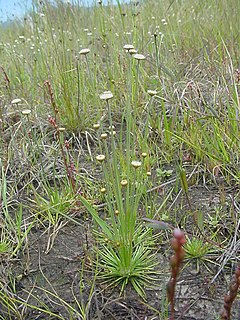
Syngonanthus is a genus of plant in family Eriocaulaceae. It is native to tropical Africa and to Latin America.

Axonopus is a genus of plants in the grass family, known generally as carpet grass. They are native primarily to the tropical and subtropical regions of the Americas with one species in tropical Africa and another on Easter Island. They are sometimes rhizomatous and many are tolerant of periodic submersion.
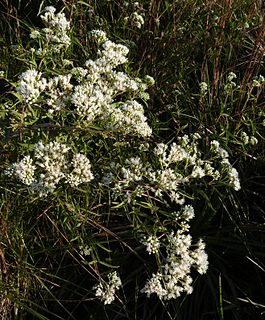
Austroeupatorium is a genus of plants native primarily to South America, including herbaceous perennials and shrubs. The native range is focused on eastern South America and extends as far north as Panama and Trinidad and as far west as Bolivia.
Luziola (watergrass) is a genus of New World in the grass family, native to North and South America including the West Indies.
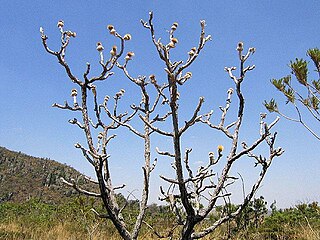
Wunderlichia is a genus of Brazilian trees in the gerbera tribe within the daisy family.

Hypenia is a genus of flowering plants in the mint family, Lamiaceae, first described as a genus in 1988. It is native to South America and southern Mexico.
- Hypenia aristulata(Epling) Harley - Goiás
- Hypenia brachystachys(Pohl ex Benth.) Harley - southern Brazil
- Hypenia calycina(Pohl ex Benth.) Harley - Brazil
- Hypenia concinna(Benth.) Harley - Tocantins
- Hypenia crispata(Pohl ex Benth.) Harley - Goiás
- Hypenia densiflora(Pohl ex Benth.) Harley - Brazil
- Hypenia durifolia(Epling) Harley - Brazil
- Hypenia gardneriana(Benth.) Harley - Brazil
- Hypenia glauca(A.St.-Hil. ex Benth.) Harley - Brazil, Paraguay
- Hypenia inelegans(Epling) Harley - Brazil
- Hypenia irregularis(Benth.) Harley - Brazil
- Hypenia macrantha(A.St.-Hil. ex Benth.) Harley - Brazil
- Hypenia macrosiphon(Briq.) Harley - Brazil, Paraguay, Bolivia
- Hypenia marifolia(Benth.) Harley - Brazil
- Hypenia micrantha(Benth.) Harley - Mato Grosso
- Hypenia paniculata(Benth.) Harley - Brazil
- Hypenia paradisi(Harley) Harley - Goiás
- Hypenia pauliana(Epling) Harley - Brazil
- Hypenia perplexa(Epling) Harley - Brazil
- Hypenia pruinosa(Pohl ex Benth.) Harley - Brazil
- Hypenia reticulata(Mart. ex Benth.) Harley - eastern Brazil
- Hypenia salzmannii(Benth.) Harley - Brazil, Guyana, Venezuela
- Hypenia simplex(A.St.-Hil. ex Benth.) Harley & J.F.B.Pastore - Brazil
- Hypenia subrosea(Harley) Harley - Goiás
- Hypenia violaceaMart.Gord. & S.Valencia - Guerrero, Oaxaca
Hyptidendron is a genus of plants in the family Lamiaceae, first described in 1849. The entire genus is endemic to South America.
- Hyptidendron amethystoides(Benth.) Harley - eastern Brazil
- Hyptidendron arboreum(Benth.) Harley - Guyana, Venezuela, Colombia, Ecuador, Peru, northwestern Brazil
- Hyptidendron arbusculum(Epling) Harley - Brazil
- Hyptidendron asperrimum(Spreng.) Harley - eastern Brazil
- Hyptidendron canum(Pohl ex Benth.) Harley - Brazil, Bolivia
- Hyptidendron caudatum(Epling & Játiva) Harley - Brazil
- Hyptidendron claussenii(Benth.) Harley - Minas Gerais
- Hyptidendron conspersum(Benth.) Harley - Bahia
- Hyptidendron dictiocalyx(Benth.) Harley - Goiás
- Hyptidendron eximium(Epling) Harley & J.F.B.Pastore - Mato Grosso
- Hyptidendron glutinosum(Benth.) Harley - Brazil, Bolivia
- Hyptidendron leucophyllum(Pohl ex Benth.) Harley - southern Brazil
- Hyptidendron rhabdocalyx(Mart. ex Benth.) Harley - southern Brazil
- Hyptidendron rondonicum(Harley) Harley - Brazil
- Hyptidendron unilaterale(Epling) Harley - southern Brazil
- Hyptidendron vauthieri(Briq.) Harley - southern Brazil
- Hyptidendron vepretorum(Mart. ex Benth.) Harley - Minas Gerais
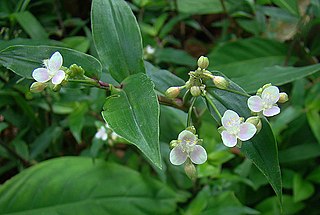
Tripogandra is a genus of flowering plants in the spiderwort family, Commelinaceae. It is native to the Western Hemisphere from central Mexico and the West Indies south to Argentina.
Cyanocephalus is a genus of flowering plants belonging to the family Lamiaceae.
















